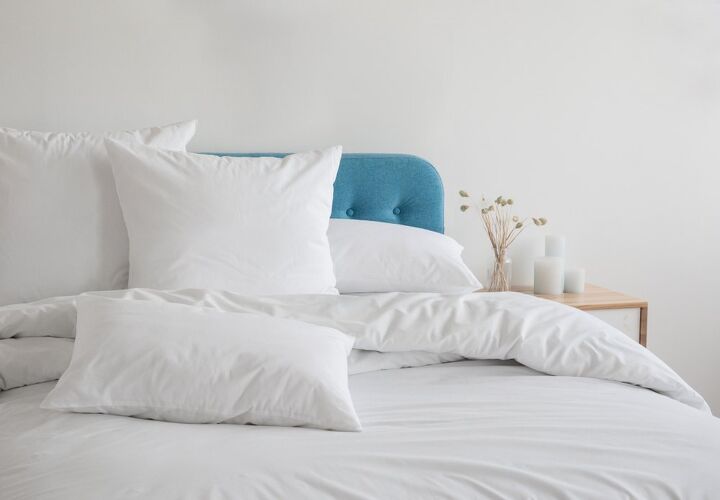25+ Types Of Pillow Shapes (With Photos)

Choosing the right pillow for your night’s rest is almost as important a decision as choosing your mattress. If you frequently awake with aches and pains it’s possible that you are using the wrong pillow. While everyone is familiar with the standard rectangular-shaped pillow, there are a number of other shapes and sizes that can help you stay comfortable as you sleep.
Some of the most common types of pillow shapes include bed pillows, contour pillows, body pillows, pregnancy pillows, bolsters, husband pillows, wedge pillows, lumbar pillows, CPAP pillows, bath pillows, knee pillows, leg rest pillows, cooling pillows, and various types of travel pillows. Pillows can also be categorized based on the fill material, with some of the most popular being down, down alternative, latex, and memory foam.
This comprehensive guide outlines the different pillow types to help you understand which is ideal for your preferred sleeping position.
Do You Need an Interior Decorator?
Get free, zero-commitment quotes from pro contractors near you.

Pillows Based on Shape
One of the most common ways to distinguish the various types of pillows is by their shape. Each of the following pillows are specially designed to provide a different level of support and comfort while you sleep. These pillows also come in various materials, which have their own unique advantages and disadvantages.
Not every type of pillow falls into a one-size-fits-all category, so understanding their characteristics and differences can help ensure that you find a shape that is the right fit for both your bed and your body.
1. Bed Pillows
Bed pillows are as simple as they sound – pillows found in your bed and usually used to rest your head on during the night. These are standard rectangular pillows and likely the type that you have in your bedroom. While all bed pillows have the same shape, they come in several different sizes:
- Standard Pillows: Standard pillows sizes are, irrefutably, the most popular and widely available type of pillow, as they are suited for all bed sizes up to a queen. For the average sized person, these pillows provide sufficient comfort. Measuring 20 inches by 26 inches, standard pillows will fit standard and queen-sized pillowcases.
- Super Standard Pillows: Measuring 20 inches by 28 inches, super standard pillows are just slightly longer than their standard counterparts. These are a great choice for those that tend to roll around a lot in the night or just prefer a little extra support between the mattress and their head. They are suitable for fitting across twin sized beds and will fit both standard and queen pillowcases.
- Queen Pillows: Following close behind standard pillows, queen size pillows are the next popular option. They measure 20 inches by 30 inches, but can still fit inside a standard pillowcase. Though, the pillow may be slightly compressed and have a firmer feel. Opting for a queen size pillow case will allow the pillow to expand under the weight better.
- King Pillows: Measuring 20 inches by 36 inches, king pillows are typically used for larger body types or to extend the width of a king size bed. They can deliver a similar feel to body pillows and are helpful for people who suffer from frequent joint or muscle pain.
2. European Pillows
Instead of being rectangular in shape, European pillows are square – measuring 26 inches by 26 inches. For this reason, they tend to be used for more decorative purposes than for function. Though, these pillows are great as back support and to cushion joints. Instead of being used for head support, European pillows are more suitable for additional body comfort.
3. Contour Pillows
Contour pillows are a firmer style pillow, with a slight dip that is specifically designed to provide support for the head and neck. These pillows are the ideal choice for back sleepers, as they help to keep the neck and spine properly aligned while you sleep.
4. Body Pillows
Body pillows are essentially oversized pillows that are designed to run the length of your body. Most measure 20 inches by 54 inches in length and can provide support of painful joints, as well as promote a better sleeping position. These pillows are best suited for side sleepers.
They are commonly placed along the headboard and can serve as joint and head pressure point relief all in one design. Whether you live alone or love to spoon, a body pillow can make a great replacement cuddly buddy.
5. Pregnancy Pillows
As the name suggests, pregnancy pillows are designed for pregnant women. Of course, if you’re pregnant, you’ll no longer be able to sleep on your back or your stomach. Your only option is side sleeping and you need something to provide support for your baby bump. This is where pregnancy pillows come in.
While these pillows like somewhat similar to body pillows, they are specially designed to comfort and support your belly as it grows during your pregnancy. There are several different sizes and shapes of pregnancy pillows, but all are meant to alleviate stomach and back pain or pressure as you sleep.
Pregnancy pillows usually come in two main styles: C-shaped and U-shaped. While both options will support your pregnant body, each offers a distinct feel, sleep position, and level of pressure. Choosing between the two depends on your individual needs and preferences.
6. Travel Pillows
Travel pillows often measure 12 inches by 16 inches, and are designed for easy packing or for small children. These pillows only exist to be useful while traveling in a car or plane. However, there are a couple different styles and shapes that also fall under the category of “travel pillow:”
- Neck Pillows: These small, portable pillows allow you to sleep while in a seated position. As such, they are great for when you’re traveling in a car, plane, bus, train, or any other transportation that requires you to sit. The most common form of neck pillow goes around your neck and rests on your shoulders. Then, tilt your head to one side to rest it on the pillow and comfortably sleep upright. When not in use, you can easily store your neck pillow in your luggage.
- Ostrich Pillows: Originally created by Studio Banana Things, the term “Ostrich pillow” is now used to describe any sort of portable travel pillow that supports your head and neck, while also covering your eyes. It is essentially a pillow that your slide over your head, making them ideal for napping or sleeping during daylight hours.
- Inflatable Pillows: If you plan to pack a little lighter, you can opt for an inflatable pillow. When not being used, inflatable pillows fold up flat and take up very minimal space in your luggage. Then, when you want to use the pillow, simply pull it out and blow it up to inflate it. Nowadays, these pillows also feature soft fabric surfaces to add comfort to their design.
7. Wedge Pillows
Shaped similar to a massive doorstop, wedge pillows come in a range of sizes. However, they are all designed to help you rest or sleep in an upright position. These pillows are affordable pain-relieving devices that are commonly used by those who suffer from breathing problems or acid reflux at night.
Wedge pillows are constructed from a firmer filling, such as memory foam or poly foam. That way, the pillow will maintain its shape no matter how much weight is applied. Although wedge pillows are usually placed under your back, they may also be positioned under your legs to relieve your thighs.
8. Leg Rest Pillows
Leg rest pillows are similar in design to wedge pillows, but are specially designed for your lower body. These pillows help elevate your body from the thigh down. They are intended to be used for swelling in the legs, injury recovery, and back pain. A leg rest pillow is positioned right below the buttocks, elevating your thighs, angling underneath the knees, and providing a flat surface for your legs to rest on.
9. Bolster or Roll
A rolled pillow, also called a bolster or “yoga bolster,” may be used as a decoration on your bed, but it’s actually most often used to deliver leg and neck support. The term “bolster” is a catch-all name that refers to a virtually cylindrical pillow that can be used to support numerous parts of the body during rest and relaxation.
When used during yoga, bolsters help the user hold difficult positions. Though, their round shape makes these pillows multi-purpose. You can position it under your back, neck, between your legs, or any other position to help you get more comfortable. Placing a bolster pillow under your knees while laying down can also aid spinal alignment.
The main drawback to these pillows is that it cannot support an individual area as well as a pillow that is specially designed for a particular body part. Though, this weakness can be used to your advantage by using the pillow for various purposes.
10. Husband Pillows
Of all the pillow types on this list, the husband pillow has the most names. This type of pillow may also be referred to as a girlfriend pillow, boyfriend pillow, bedrest pillow, and reading pillow, among others. It gets its because as you lean back, the two arms on either side of the pillow hug your sides, similar to when your significant other holds you from behind.
Husband pillows are designed to support your back while sitting upright. They are often used to use your phone or tablet, read, or any other activity that is more comfortable in a propped-up position. These pillows are not meant to be used while sleeping.
11. Lumbar Pillows
When you hear the term “lumbar support,” this refers to providing reinforcement for your lower back. Lumbar pillows do just that, offering some much-needed relief for your lower back as you sleep. These pillows have a flat, but firm, design. They are created to fit into the curve of your lower back and are ideal for both back and side sleepers.
12. CPAP Pillows
If you have sleep apnea, you know how difficult it can be to sleep comfortably while using a CPAP mask. When you use a regular-sized pillow, you’ll only squish the mask against your face, causing uncomfortable pressure that will keep you up at night. Fortunately, CPAP pillows are designed to support and frame your neck, with its cut-out or recessed section for your CPAP mask to sit in.
While the name suggests these pillows are only meant to be used with CPAP machines, this is not the case. These pillows are appropriate for any type of sleep apnea mask, including APAP and BiPAP.
13. Bath Pillows
If you enjoy relaxing in the bath, you know how uncomfortable resting your neck on the edge of your tub can be. A bath pillow is designed to attach directly the side of your bathtub, delivering a supportive and comfortable place for your head to rest while you bathe.
As bath pillows are absolutely going to get wet while in use, they are usually made out of mildew and mold-resistant materials. These pillows use a series of suction cups to hold the pillow in place on your bathtub and prevent it from slipping.
14. Cooling Pillows
If you frequently overheat at night and wake up sweating, whether it’s caused by warm weather or hot flashing, consider a cooling pillow. These pillows are designed to help the user stay cool and comfortable as they sleep. Cooling pillows usually consist of two distinct parts: a foam pillow and a flat plastic pack with cooling gel inside that sits on top. The purpose of the cooling gel pack is to absorb and disperse heat, which helps regulate your body temperature at night.
15. Knee Pillows
If you suffer from joint, knee, or hip pain when you sleep, your doctor may have advised you to try sleeping with a pillow between your knees. While you can certainly use a standard bed pillow, a knee pillow is the ideal solution to provide the proper support you need. They consist of a foam pillow with contours on either side to fit into the curves of your legs.
As the name suggests, knee pillows are intended to help keep side sleeper’s knees separate by resting them on your knees. Though, they can also be positioned between your thighs or lower than your knees to achieve similar results. Choose a position that feels most supportive and comfortable to you.
Pillow Fill Materials
Aside from shapes and sizes, pillows can also be categorized based on the material used to fill them. In fact, the fill material may be used to describe a pillow. For example, a pillow filled with memory foam is often referred to as a “memory foam pillow.”
It’s important to understand your options, as the firmness or softness of a pillow is usually determined by what material and how much of it is inside.
1. Down Pillow
Down refers to the soft fibers near the skin of ducks, geese, and swans that keeps them warm. This material is one of the softest options available. It’s also easy to shape, long-lasting, and excellent at retaining warmth. The drawbacks to down pillows is that they are expensive, can cause allergies, and the down is taken from animals. So, if you want an ethically sourced pillow, look for one that is certified by the Responsible Down Standard.
Ideal for: Back, side, and stomach sleepers.
2. Down Alternative Pillow
Down alternative pillows are a synthetic alternative of conventional down pillows. They are usually filled with polyester, which helps imitate the feel of down. The added benefit of using polyester is that the pillow is hypoallergenic and more cost-effective. So, if you want the soft feel of down without using real feathers, consider a down alternative pillow.
Ideal for: Back and side sleepers.
3. Feather Pillow
Feather describes any fill material that consists of bird feathers, which usually comes from geese or ducks. This is a traditional type of filling that is great for those looking for a supportive and comfortable option. Over time, feather pillows tend to flatten out and lose their support, requiring you to frequently fluff your pillow. To combat this issue, these pillows are often filled with down. So, those who are allergic to down should seek out another alternative.
Ideal for: Back and side sleepers.
4. Cotton Pillow
Nowadays, pillows with cotton stuffing are few and far between. Though, cotton pillows are great for those who are allergic to synthetic materials. They provide excellent support and are easy to clean. Though, it’s important to note that pillows that state they are “100% cotton,” are usually referring to the pillowcase.
Ideal for: Back, side, and stomach sleepers.
5. Latex Pillow
Latex is a natural polymer that may be synthesized or derived from plants. It is a soft rubber-like material that is gaining popularity as a pillow filling due to the high level of support it provides for the head and neck. Latex pillows are available in solid and shredded form. Though, be wary of latex-blend pillows, as they often contain polyurethane foam which may be toxic.
Ideal for: Back and side sleepers.
6. Memory Foam Pillow
Originally created by NASA, memory foam is gaining in popularity because it naturally contours to your body. This means that memory foam pillows can work for all sleeping positions. Your head and neck will mold to the pillow into the most comfortable position for your needs. It is also is slow to spring back into shape.
Ideal for: Back, side, and stomach sleepers.
7. Shredded Memory Foam Pillow
Shredded memory foam is an alternative to traditional memory foam as a pillow filling. Since shredded memory foam can be added to the pillow or removed based on your needs, it is great for people with varying sleeping preferences.
Ideal for: Back and side sleepers.
8. Bamboo Pillow
In the sleep industry, bamboo pillows have been a rising trend for quite some time due to their moisture-absorbing abilities and antibacterial properties. Most bamboo pillows are filled with shredded foam and then consist of a bamboo viscose shell. This means that you get to enjoy all the benefits of a shredded memory foam pillow, with the cooling and hypoallergenic properties of bamboo. The drawback to this option is that these pillows can heavy, be difficult to clean, and off-gas chemicals over time.
Ideal for: Back sleepers.
Do You Need an Interior Decorator?
Get free, zero-commitment quotes from pro contractors near you.

9. Microbead Pillow
Microbead pillows consist of a synthetic filling called uniform polymer particles. As a synthetic alternative to buckwheat, these pillows also offer breathability and the ability to conform to the shape of your head. However, these pillows can lose their shape fast, tend to retain heat, and off-gas chemicals.
Ideal for: Back sleepers.
10. Buckwheat Pillow
Buckwheat pillows have been a popular choice in Asia for many years, but are just now making their way to North America. Filled with buckwheat shells, these pillows are firm, but breathable and cooling. They have a similar feed to microbead pillows. However, on the downside, buckwheat pillows can be heavy, too firm for some users, and noisy because of the shells inside.
Ideal for: back and stomach sleepers.

Jessica considers herself a home improvement and design enthusiast. She grew up surrounded by constant home improvement projects and owes most of what she knows to helping her dad renovate her childhood home. Being a Los Angeles resident, Jessica spends a lot of her time looking for her next DIY project and sharing her love for home design.
More by Jessica Stone






























![Standard Dining Room Table Dimensions [for 4, 6, 8, 10 and 12 People]](https://cdn-fastly.upgradedhome.com/media/2023/07/31/9074335/standard-dining-room-table-dimensions-for-4-6-8-10-and-12-people.jpg?size=350x220)








